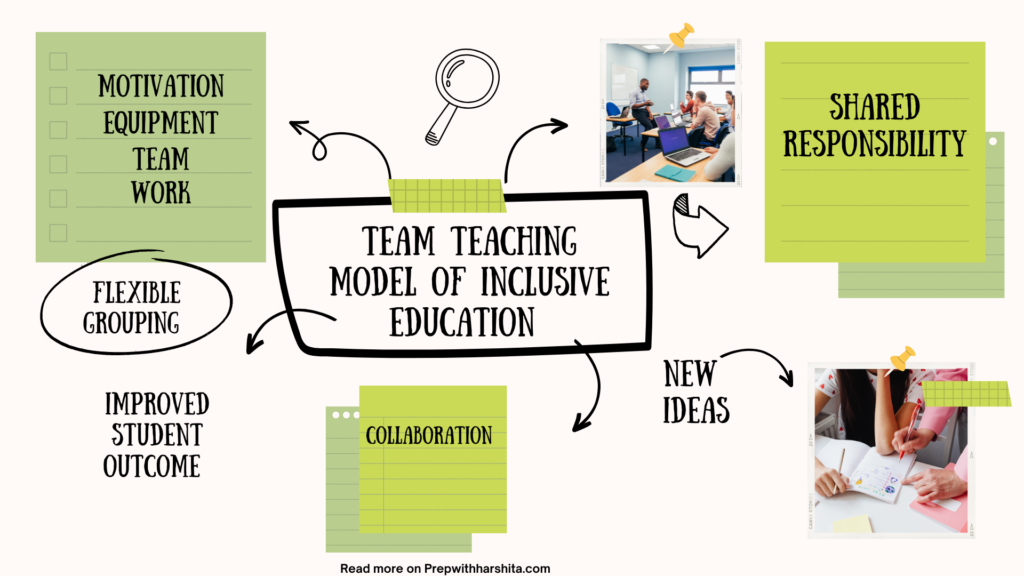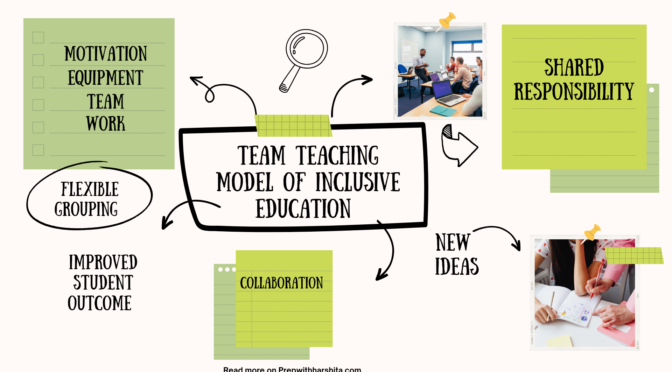The team teaching model of inclusion, also known as co-teaching, is an approach to inclusive education that involves two or more teachers working together in the same classroom to support the learning needs of all students, including those with disabilities or other special needs.
The model emphasizes collaboration, shared responsibility, and the integration of specialized support within the general education setting.
Here are some key features and benefits of the team teaching model:
- Collaboration: In team teaching, general education teachers and special education teachers collaborate closely to plan lessons, instructional strategies, and assessments. They share their expertise and knowledge to create a supportive learning environment for all students.
- Shared Responsibility: Both teachers share the responsibility for teaching and meeting the diverse needs of students. They work together to provide differentiated instruction, address individual learning goals, and modify curriculum and materials as needed.
- Inclusive Environment: The team teaching model promotes an inclusive classroom environment where students with special needs are fully included and actively participate in the general education curriculum alongside their peers. It helps reduce the stigma associated with special education and fosters a sense of belonging for all students.
- Individualized Support: With multiple teachers in the classroom, students receive individualized support and attention. They can benefit from small group instruction, one-on-one assistance, or additional guidance based on their specific learning needs and abilities.
- Flexible Grouping: Team teaching allows for flexible grouping arrangements, where students can be grouped based on their needs, interests, or learning styles. Teachers can easily organize and manage small group activities or stations, ensuring that every student receives appropriate instruction and support.
- Professional Development: The team teaching model encourages ongoing professional development for both general and special education teachers. They learn from each other’s expertise, share best practices, and develop a deeper understanding of inclusive teaching strategies.
- Positive Role Modeling: The presence of a special education teacher in the general education classroom can serve as a positive role model for all students. It promotes empathy, understanding, and respect for individual differences.
- Improved Student Outcomes: Research suggests that the team teaching model can lead to improved academic and social outcomes for students with disabilities. It provides them with greater access to the general education curriculum, promotes peer interaction and collaboration, and enhances overall learning experiences.
It’s important to note that successful implementation of the team teaching model requires effective communication, collaboration, and coordination between teachers, as well as ongoing support from school administrators.
Training and professional development opportunities should be provided to help teachers develop the necessary skills and knowledge for effective co-teaching.
Also Read: PWD Act 1995

Also Visit: Prep with Harshita


hello there and thanks for your information ?I抳e definitely picked up something new from right here. I did on the other hand expertise some technical issues using this website, as I skilled to reload the site lots of times previous to I could get it to load correctly. I have been brooding about in case your hosting is OK? Now not that I’m complaining, however slow loading cases times will often have an effect on your placement in google and could injury your high-quality ranking if advertising and ***********|advertising|advertising|advertising and *********** with Adwords. Anyway I抦 including this RSS to my email and could look out for much extra of your respective intriguing content. Make sure you update this once more soon..
equilibrado de ejes
Dispositivos de equilibrado: esencial para el operación uniforme y productivo de las dispositivos.
En el mundo de la ciencia contemporánea, donde la efectividad y la estabilidad del aparato son de gran importancia, los aparatos de ajuste cumplen un función esencial. Estos dispositivos adaptados están concebidos para balancear y estabilizar elementos dinámicas, ya sea en dispositivos industrial, medios de transporte de movilidad o incluso en dispositivos caseros.
Para los expertos en reparación de dispositivos y los ingenieros, operar con aparatos de calibración es importante para asegurar el operación suave y fiable de cualquier dispositivo dinámico. Gracias a estas alternativas innovadoras modernas, es posible reducir significativamente las vibraciones, el estruendo y la tensión sobre los sujeciones, mejorando la longevidad de piezas importantes.
También significativo es el papel que tienen los aparatos de calibración en la asistencia al comprador. El ayuda experto y el reparación constante utilizando estos sistemas permiten ofrecer soluciones de excelente nivel, mejorando la contento de los consumidores.
Para los propietarios de empresas, la financiamiento en sistemas de calibración y dispositivos puede ser clave para aumentar la productividad y rendimiento de sus dispositivos. Esto es especialmente trascendental para los empresarios que gestionan pequeñas y intermedias negocios, donde cada detalle cuenta.
También, los dispositivos de ajuste tienen una amplia implementación en el ámbito de la prevención y el gestión de calidad. Habilitan encontrar potenciales problemas, evitando reparaciones caras y daños a los dispositivos. Además, los resultados obtenidos de estos equipos pueden aplicarse para perfeccionar procesos y potenciar la presencia en sistemas de consulta.
Las sectores de utilización de los equipos de ajuste incluyen variadas industrias, desde la elaboración de bicicletas hasta el monitoreo del medio ambiente. No importa si se considera de importantes producciones industriales o reducidos talleres caseros, los equipos de equilibrado son esenciales para promover un funcionamiento efectivo y sin presencia de interrupciones.
Fantastic website you have here but I was wanting to know if you knew of any discussion boards that cover the same topics discussed in this article? I’d really love to be a part of community where I can get advice from other knowledgeable individuals that share the same interest. If you have any suggestions, please let me know. Cheers!
It is indeed my belief that mesothelioma is definitely the most dangerous cancer. It’s got unusual attributes. The more I look at it the greater I am convinced it does not conduct itself like a real solid tissues cancer. If mesothelioma is often a rogue viral infection, therefore there is the prospects for developing a vaccine and also offering vaccination for asbestos uncovered people who are really at high risk associated with developing potential asbestos linked malignancies. Thanks for discussing your ideas about this important health issue.